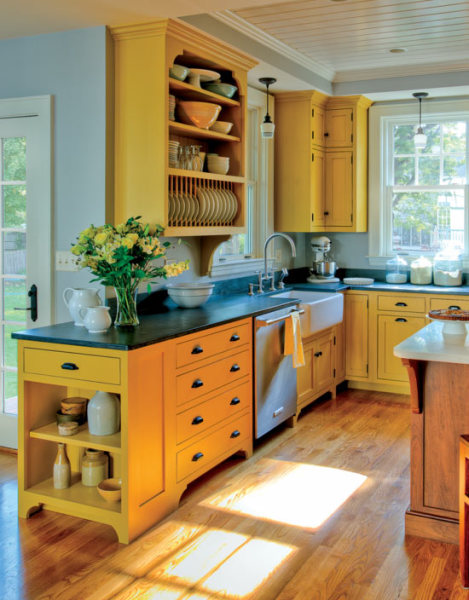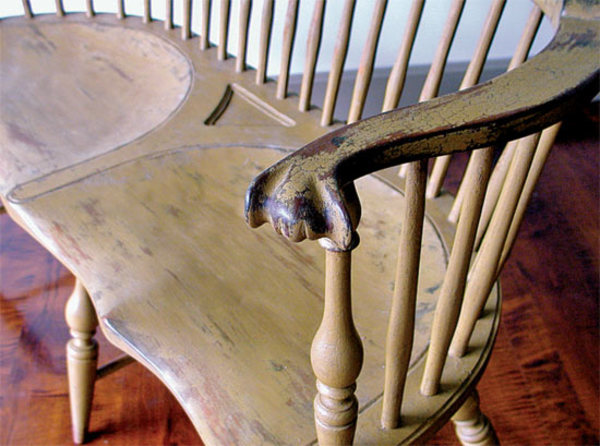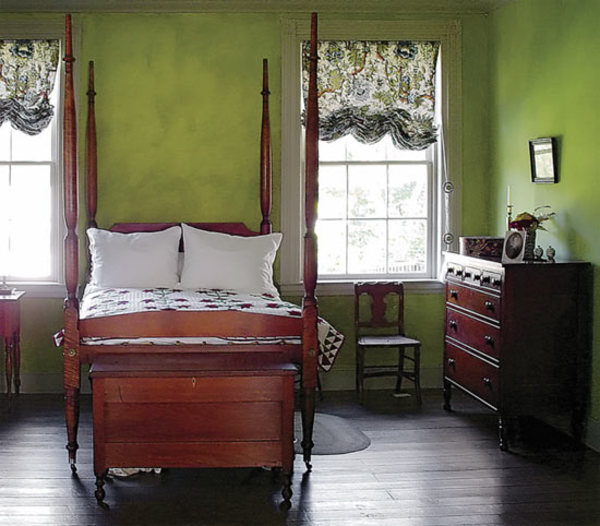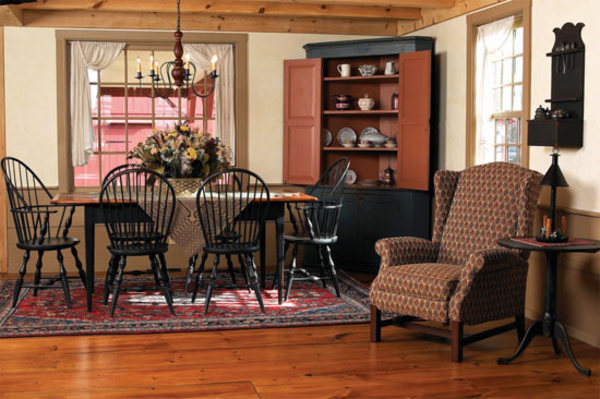
Crown Point Cabinetry used a custom-blended milk paint for these Shaker-inspired cabinets.
Before the 1870s, ready-made paint was unknown. Each batch had to be compounded by hand from three basic components: dry pigment, a liquid vehicle to carry it, and a binder to hold the mixture together. Milk paint’s popularity was due in part to its inexpensive ingredient list of natural earth pigments, slaked lime, and a milk protein called casein. Milk paint is the original “organic” paint.
Real milk paint continues to be made from all-natural ingredients, making it a popular choice for those concerned about toxic substances in the home and the environment. It’s popular for other reasons as well. In appearance, it’s unlike any other paint on the market. The finish is flat, yet has subtle differences in shading that mimic the patina of age.

Chris Harter’s museum-quality pieces feature milk paint in classic colonial colors with hand-rubbed and distressed finishes.
Milk paint also lends itself well to different effects, like that achieved by the Old Fashioned Milk Paint Company’s Antique Crackle, a natural gelatin-based product. When brushed over milk paint, it results in an alligatored appearance that suggests great age. Milk paint also can be burnished—that is, some of the top color sanded away—to reveal the wood beneath. If two colors are applied, then burnishing allows the undercoat to show through for a pleasing layered effect.
Milk paint is usually offered in history-based palettes. The Colonial Williamsburg Buttermilk Paints from Old Village Paint Colors, for example, derive their colors from the collections of the Abby Aldrich Rockefeller Folk Art Center in Williamsburg, Virginia. Milk paint palettes are, like those in colonial America, deep and rich, derived from natural deposits in the earth, primarily oxide-containing clays: ochre yellows, umbers, siennas.
A common misconception about milk paint is that the palette is limited to these intense shades. In fact, there is great flexibility in the color range. Milk paint comes in dry powder form, which means the painter has total control over the outcome. Depending on how much water is added, the final effect can range from a translucent wiping stain to a soft color wash to a solid color. In addition, pigment powders can be mixed to create custom shades. The Real Milk Paint Company’s website features a handy chart of 1870s color mixing formulas, ensuring you have the authentic recipe for creating that elusive green-bronze or claret.

Walls at the 1835 Wylie House in Bloomington, Indiana, are finished in milk paint donated by the Old Fashioned Milk Paint Company.
Other great features of milk paint: The color doesn’t fade over time, nor does it chip or peel, because it is absorbed into porous surfaces. It does, however, stain easily. Most companies recommend that it be sealed in high-traffic areas, and thus offer complementary lines of sealants. The Homestead House Paint Company carries a line of all-natural hemp oil, beeswax, or varnish finishing products.
In the distant past, homeowners added linseed oil or tar derivatives to strengthen milk paint’s durability for outdoor use. Today’s needs are more varied, and milk paint companies have responded. Most carry an additive product that will allow paint to adhere to non-porous surfaces. For stubborn surfaces like tile or laminates, there are acrylic bonding primers. More recently, self-priming paints have hit the market, making milk paint a possibility for outdoor and furniture projects.

Painting wainscots, trim, and freestanding furniture in milk paint helps tie elements in a reproduction home together, giving it an authentic early American feel.
If you’re intrigued by the charm and character of milk paint but haven’t the inclination to mix your own paints, simulated milk paint is another alternative. Sold as a liquid, these paints usually contain a synthetic paint extender.
In addition to its line of 18 historical colors, Olde Century Colors has a crackle medium and an antiquing liquid. General Finishes offers a line of acrylic “milk paints” for use on furniture; combined with the brand’s glaze effects, these paints produce decorative finishes prized by furniture-makers and craftspeople.
Final proof that milk paint has become the new “it” paint is Anna Sova Luxury Organics’ line of milk paints, which are marketed as containing “90% food ingredients,” and have luscious names like Raspberry Custard and Currant Jam.







